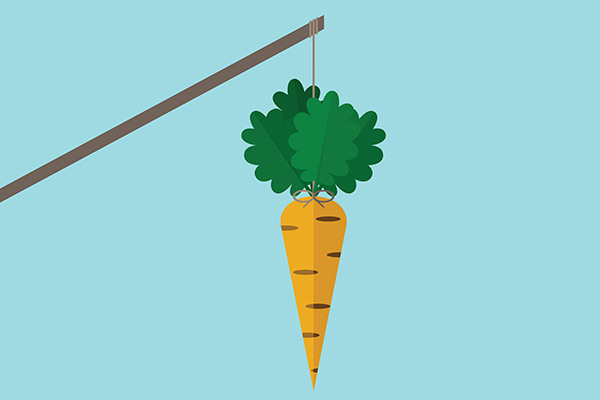A classic New Yorker cartoon of 1928 shows a sullen little girl and her mother sitting at the dinner table. “It’s broccoli, dear,” the mother says hopefully. The daughter retorts “I say it’s spinach and I say the hell with it.”
We’ve all been there with something. Peas. Whole-wheat pasta. Cheese. Inveigling kids into decent diets isn’t always a bowl of organic cherries.
Luckily there are a lot of delightful and encouraging books and resources on the topic of healthy eating – a subject that is garnering a lot of attention right now, what with the upsurge in childhood obesity and the growing interest in local and organic foods.
Take a look at some of these:
Table of Contents
HOW CARROTS WON THE TROJAN WAR
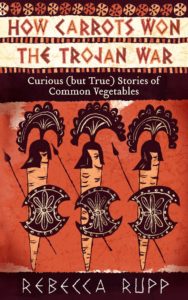
|
My latest non-fiction book, How Carrots Won the Trojan War (Storey Publishing, 2011) is a catchy science and history of garden vegetables. It’s an adult book, but is packed with stories and information adaptable for a wide range of educational and just plain interesting purposes. Find out, for example, about the Burmese Cucumber King, Henry Ford’s carrot obsession, and the pirate who discovered bell peppers, and discover what corn had to do with Dracula and why pumpkins sometimes explode. |
PICKY AND NOT-SO-PICKY EATERS
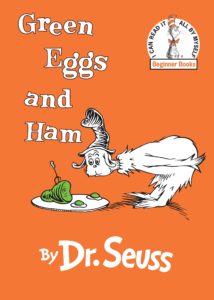 |
In Dr. Seuss’s Green Eggs and Ham (Random House, 2005), the narrator will not – absolutely WILL NOT – eat green eggs and ham. Until he finally tries them. A great book for picky eaters ages 3-7. |
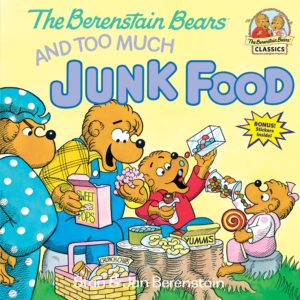 |
In Stan and Jan Berenstain’s The Berenstain Bears and Too Much Junk Food (Random House, 1985), Brother and Sister Bear are hooked on sweets and other unhealthy snacks – and they’re getting chubby. Mama Bear, with some back-up from Dr. Grizzly, helps them change their eating habits. For ages 3-7. |
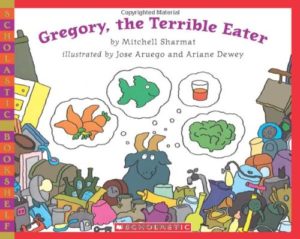
|
In Mitchell Sharmat’s Gregory the Terrible Eater (Scholastic, 2009), Gregory, a little goat, spurns normal goat foods – tin cans, shoes, rubber tires – in favor of healthful fruits and vegetables. His appalled parents take him to the doctor. For ages 4-8. |
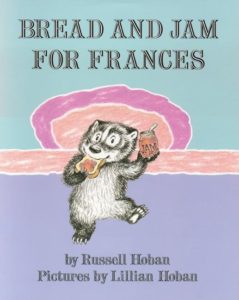
|
Frances, the endearing little badger of Russell Hoban’s Bread and Jam for Frances (HarperCollins, 2008) decides to eat nothing for breakfast, lunch, and dinner but her favorite bread and jam. Her parents go along with it – and Frances finally discovers that she’s awfully sick of jam. For ages 4-8. |
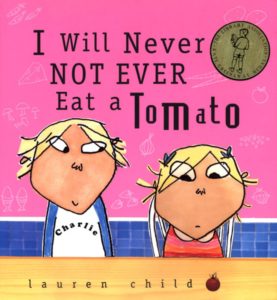
|
In Lauren Child’s wonderful I Will Never Not Ever Eat a Tomato (Candlewick, 2003), big brother Charlie – who has a much more creative take on food than “It’s broccoli, dear” – convinces his picky little sister Lola to eat by reinventing carrots as orange twiglets from Jupiter, mashed potatoes as cloud fluff from the top of Mount Fuji, and fish sticks as Ocean Nibbles. (Mermaids eat them!) For ages 4-8. |
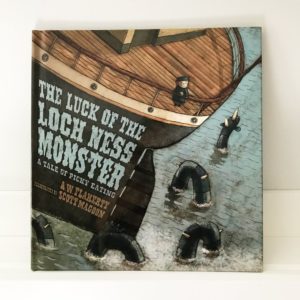
|
In Alice Weaver Flaherty’s The Luck of the Loch Ness Monster (Houghton Mifflin Books for Children, 2007), young Katerina-Elizabeth, on a transatlantic trip to visit her grandmother in Scotland, tosses her healthy but hated breakfast oatmeal overboard every morning. Her oatmeal is promptly gobbled up by a small sea worm, who grows to monstrous size and ultimately follows Katerina-Elizabeth’s ship up the River Ness, where it makes itself at home in a Scottish lake. For ages 4-8. |
| For info on the bennies of oatmeal for breakfast, see NPR’s A Better Breakfast Can Boost a Child’s Brainpower. | |
| Oatmeal Crafts has instructions for making oatmeal clay and oatmeal-box piggy banks. | |
| Even more reasons to empty the oatmeal box: Artists Helping Children has instructions for many creative oatmeal-box crafts, among them a fish tank diorama, a planetarium, a hand puppet, a drum, and a doll cradle. | |
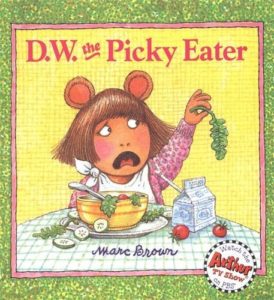
|
In Marc Brown’s D.W. the Picky Eater (Little, Brown Books for Young Readers, 1997), Arthur’s little sister won’t eat anything with eyes, or pickles, tomatoes, mushrooms, eggplant, pineapple, parsnips, cauliflower, or liver (never), or – especially – spinach. (“Face it,” said Arthur. “You are a picky eater.”) D.W.’s eating habits cause all kinds of trouble until, at her grandmother’s birthday dinner, she orders Little Bo Peep Pie – and enjoys every bite before discovering that it’s made of…spinach. For ages 4-8. |
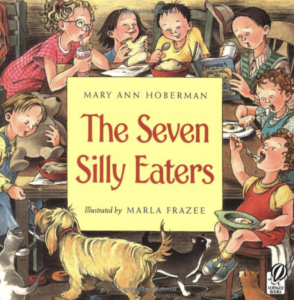
|
The seven Peters children, of Mary Ann Hoberman’s rhyming picture-book The Seven Silly Eaters (Sandpiper, 2000) are all picky eaters: Peter insists on milk of the proper (just-warm) temperature; Lucy demands homemade lemonade; Jack eats nothing but applesauce; Mac wants his oatmeal strained. The harried Mrs. Peters struggles to cope – and then, for her birthday, the picky seven solve all their problems by making a very imaginative multi-ingredient birthday cake. For ages 5-9. |
| Try Mrs. Peters’s Birthday Cake recipe. | |
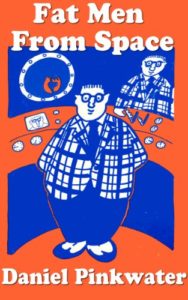
|
In Fat Men from Space by the incomparable Daniel Pinkwater (Yearling, 1980), overweight alien invaders in knit ties arrive and devour all the junk food on earth, planning to enslave the populace and force them to make more. William, forewarned of their intentions by picking up radio transmissions through a filling in his tooth, helps foil the plot – but once the invaders are gone, there’s nothing left to eat but vegetables, milk, and whole-grain bread. For ages 8-11. |
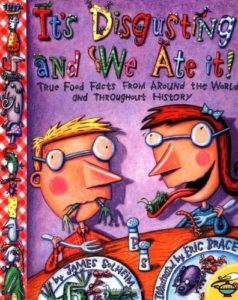 |
James Solheim’s It’s Disgusting and We Ate It! is a (true) account of off-putting foods from around the world and throughout history, from Australian witchetty grubs to Magellan’s rat stew. For ages 8-12. |
